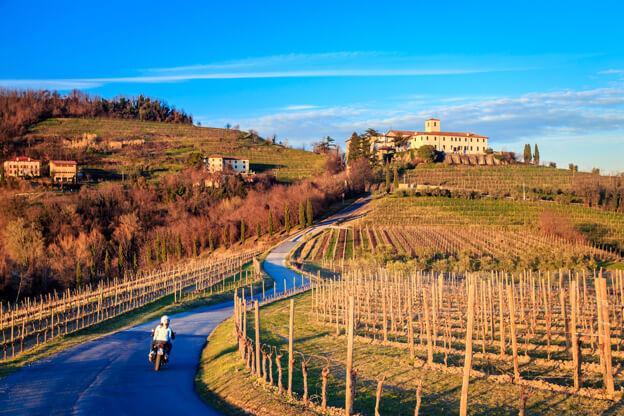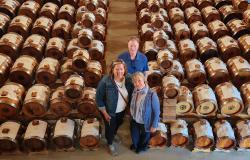When it comes to Italian destinations, some regions get all the love, and others…don’t. Such is the case with Friuli Venezia Giulia, the north-easternmost region in Italy, at the border with Austria, Slovenia and the Adriatic Sea. Few visitors seem to venture there, and yet Friuli Venezia Giulia (like all Italian regions) has a wealth of offerings catering to different interests, from nature to art, to culture and wine.
Here are three reasons why you should plan a visit to Friuli Venezia Giulia.
Amazing natural landscapes
Friuli Venezia Giulia has a variety of different landscapes, from the lagoons and sandy beaches of the coast facing the Adriatic Sea to the rugged peaks of the Friulian Dolomites, wild and spectacular.
The Friulian Dolomites are considered the most unspoilt of the entire Dolomite group, a Unesco World Heritage site. Less frequented than their Veneto and Trentino-Alto Adige counterparts, the Friulian Dolomites are a paradise for trekkers, climbers and nature lovers. There are well-maintained trails all across the regional natural park and mountain huts where to spend the night at high altitude.

If the seaside is more of your thing, then head to the popular resort town of Lignano Sabbiadoro. Halfway between Venice and Trieste, it boasts eight kilometers of sandy beach, equipped with umbrellas, chairs, bars and restaurants, and has been awarded the coveted Blue Flag.
On the opposite end of the cove is Grado, the lagoon city of Friuli Venezia Giulia, a town with an ancient history as well as clean beaches and the chance to go on boat excursions in the lagoon.
History and Art cities
Friuli Venezia Giulia was not just part of the Roman empire; one of its cities, Aquileia (another Unesco site) was the capital of the area and held strategic importance, especially during the Augustan period. Traces of the region’s Roman past can be found everywhere, including the aforementioned Aquileia, with its forum, the river port and the Basilica, one of the highest examples of early Christian art, and Cividale del Friuli, founded by the Romans to defend Italy's northeastern frontier.

[The Basilica in Aquileia.]
After the Lombards began to settle the area, the region basically split into Friuli and Venezia Giulia, one part subjected to the Lombards, the other starting to form independent city-states such as Trieste and Gorizia. Also, at the same time as the Lombards, the Alpine Slavs began moving into the eastern areas of the region. In the early Renaissance, Friuli became Venetian territory (1420), while Trieste and Gorizia remained under the Austrian Empire. It was not until the end of World War I that the two parts of the region were reunited.
Trieste, the capital of Friuli Venezia Giulia, is quite unique in the panorama of Italian cities, as it mixes Italian, Austro-Hungarian and Slovenian influences. Located on a thin strip of land between the Adriatic sea and Slovenia’s border, it has for a long time been at the crossroads of Latin, Slavic, and Germanic cultures, and this is reflected in the city’s feel and architecture. It features a medieval old city and a neoclassical Austrian quarter. Don’t miss the Miramare Castle, built on the waterfront in the 19th century.

[Trieste.]
Do not overlook Friuli Venezia Giulia’s other major cities: cosmopolitan Gorizia, with its medieval castle and Cathedral; fascinating Udine, the historic capital of Friuli, near the border with Slovenia, located between the Adriatic Sea and the Alps, where artists of the caliber of Andrea Palladio and Giambattista Tiepolo both left their imprint; Pordenone, Portus Naonis, i.e. ‘port on the Noncello River’, with its many beautiful churches, palaces, castles and villas, and Corso Vittorio Emanuele II, a remarkable example of Venetian porticoes.

[Udine.]
White Wine Heaven
Friuli Venezia Giulia definitely merits a mention when it comes to wine production. The region’s position between the Alps and the Adriatic produces a breezy, sunny microclimate that benefits its vineyards and give the terroir its unique characteristics.
Wines are made using traditional grapes such as Pinot Grigio, which, grown here, takes on unique flavors, Sauvignon, Chardonnay and Pinot Bianco; and using indigenous grapes, such as Friulano, Ribolla gialla, Malvasia istriana, Vitovska. Wines tend to be fresh and fruity.

Prestigious sweet wines like Picolit and Ramandolo, and excellent reds, among them Pignolo, Terrano and Refosco, are also produced.
Overall, there are nine DOC and three DOCG-producing areas for a total of approximately 90 million bottles made annually.
The ‘Strada del Vino e Sapori FVG’ is an itinerary that touches on several farms and wineries in the region to discover Friuli Venezia Giulia’s bounty directly from local producers.





